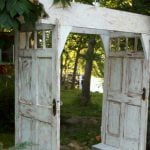Looking for the best ideas for small gardens? Limited outdoor space doesn’t have to limit your gardening dreams. With a little creativity and strategic planning, you can cultivate a beautiful and productive garden even in a small area. In this article, we will explore various tips and tricks to maximize your small garden potential, from container gardening to vertical solutions and compact plant varieties.
When it comes to small gardens, every inch counts. Whether you have a tiny balcony, a postage-stamp backyard, or just a few square feet of open space, there are many clever ways to make the most of it. In the following sections, we will dive into different strategies and techniques to help you create a thriving garden in any small space.
From choosing the right plants and layout ideas to low-maintenance options and seasonal tips, we will cover everything you need to know to set the stage for small garden success. So roll up your sleeves and get ready to transform your limited outdoor space into an oasis of greenery and beauty.
Container Gardening
When it comes to container gardening, there are plenty of options to choose from. From traditional clay pots to modern fiberglass planters, there are endless possibilities for creating a beautiful and functional small garden. Hanging baskets and vertical stackable planters also provide opportunities for maximizing space in small areas.
In addition to the flexibility and space-saving benefits of container gardening, this approach also allows for easy maintenance and mobility. Plants can be moved around to take advantage of sunlight or sheltered from harsh weather conditions as needed. It’s no wonder why container gardening consistently ranks as one of the best ideas for small gardens among garden enthusiasts.
| Advantages of Container Gardening | Description |
|---|---|
| Maximizing Space | Containers allow individuals to make the most out of limited space by utilizing vertical space and grouping plants together strategically. |
| Easy Maintenance | Plants in containers are easier to care for as they require less weeding, pruning, and watering compared to traditional gardens. |
| Mobility | Gardeners have the option to move their plants around depending on the weather or seasonal changes. |
Vertical Garden Solutions
When it comes to small gardens, utilizing vertical space is key to maximizing greenery in limited areas. Vertical garden solutions offer a creative and practical way to add visual interest and lushness to small outdoor spaces. Here are some of the best ideas for small gardens that focus on using wall space for gardening:
- Vertical Planters: Investing in vertical planters can help you create a stunning display of plants, herbs, and flowers without taking up valuable square footage. These planters can be attached to walls or fences, providing a beautiful cascade of greenery that adds depth and texture to your small garden.
- Hanging Baskets: Hanging baskets are another excellent way to bring plants to eye level in a small garden. By suspending baskets from walls or pergolas, you can add pops of color and life to otherwise bare vertical surfaces.
- Trellises and Espalier: Training climbing plants such as vines, roses, or fruit trees on trellises or along espalier structures not only saves space but also creates an elegant and picturesque feature in your small garden.
In addition to these ideas, consider incorporating wall-mounted herb gardens, living walls with modular planting systems, or even repurposing items like pallets as vertical plant displays. By thinking vertically, you can make the most of every inch in your small garden while creating a visually striking and vibrant outdoor oasis.
Whether you have a tiny balcony or a compact courtyard, vertical gardening offers endless possibilities for transforming limited wall space into a thriving green sanctuary. Experimenting with different vertical garden solutions will not only enhance the aesthetic appeal of your small garden but also inspire you to think creatively about how best to use every available surface for planting.
Compact Plant Varieties
When it comes to small garden spaces, choosing the right plants can make all the difference. Compact plant varieties are the best ideas for small gardens as they can thrive in limited space while still providing beauty and color. Here are some options to consider when selecting plants for your small garden:
- Dwarf Shrubs: These smaller versions of traditional shrubs are perfect for adding structure and texture to a small garden without taking up too much space.
- Patio Trees: Opting for trees that are specifically designed for container or small garden spaces can add height and interest without overwhelming the area.
- Bushy Herbs: Herbs like rosemary, thyme, and sage are not only useful in the kitchen, but they also stay compact and neat, making them ideal for small gardens.
In addition to selecting compact plant varieties, it’s important to consider their maintenance needs. Look for plants that are low maintenance and require minimal pruning or care. This will not only save you time and effort but will also ensure that your small garden continues to look its best with minimal intervention. By carefully choosing the right plants for your limited space, you can create a lush and thriving garden that maximizes every inch of available space.
Ultimately, when designing a small garden, it’s crucial to select plant varieties that complement each other in terms of size, shape, and color. By carefully planning and choosing the best compact plant varieties suitable for your specific space, you can create a beautiful and thriving small garden oasis.
Creative Layout Ideas
When working with limited space, it’s important to get creative with the layout of your small garden. By strategically planning and utilizing every inch, you can make the most out of your compact outdoor area. Here are some innovative ideas for maximizing the layout of your small garden.
Vertical Garden Displays
One great way to save space while still incorporating a variety of plants is by creating vertical garden displays. This can be achieved by using wall-mounted planters, trellises, or even repurposing old furniture into vertical plant holders. By going vertical, you can add lush greenery without sacrificing precious floor space.
Multi-Functional Garden Furniture
In a small garden, every piece of furniture should serve multiple purposes. Consider investing in pieces that can double as storage, such as benches with built-in compartments or coffee tables with hidden planters. This not only saves space but also adds functionality to your outdoor area.
Utilizing Pathways for Greenery
Instead of traditional concrete pathways, consider creating winding paths using stepping stones bordered by planting beds. This not only adds visual interest but also allows for additional areas for planting flowers, herbs, or vegetables. By integrating plants into the path design, you’ll maximize every inch of your small garden while adding charm and character to the space.
With these creative layout ideas, you can make the most out of every inch in your small garden. From vertically displaying plants to integrating greenery into functional furniture and pathways, there are countless ways to optimize the layout of your compact outdoor space. These innovative ideas will help you create a beautiful and efficient garden that makes the most out of limited square footage.
Low Maintenance Options
When it comes to maintaining a small garden, choosing low maintenance options can make all the difference. One of the best ideas for small gardens is to opt for plants that require minimal care and attention. This can include selecting drought-tolerant varieties that require less watering or slow-growing plants that need less frequent pruning and trimming. By choosing low maintenance options, you can spend less time on upkeep and more time enjoying your small garden oasis.
Another great way to simplify small garden care is to incorporate mulch into your garden beds. Mulch not only helps retain moisture in the soil, reducing the need for frequent watering, but it also suppresses weed growth, minimizing the time spent on weeding and maintenance. Additionally, consider installing a drip irrigation system for efficient and targeted watering, eliminating the need for hand-watering altogether.
In addition to plant selection and watering methods, incorporating hardscaping elements into your small garden can also reduce maintenance needs. Instead of a traditional grass lawn, consider using gravel or paving stones for pathways and seating areas. Not only do these alternatives require less upkeep than grass, but they also add visual interest to your small garden space.
| Low Maintenance Option | Benefits |
|---|---|
| Drought-tolerant plants | Require less watering |
| Mulch | Retains moisture, suppresses weeds |
| Hardscaping elements (gravel or paving stones) | Reduced upkeep compared to traditional grass lawn |
Functional Garden Features
When it comes to small gardens, every element should serve a purpose and maximize the limited space available. Functional garden features can add both style and utility to your outdoor oasis. From seating areas to decorative accents, there are many ways to enhance your small garden with purposeful elements.
One of the best ideas for small gardens is to incorporate multi-functional furniture pieces. Look for benches or chairs that provide seating while also serving as storage for gardening tools or extra pots. This allows you to make the most of your space by combining practicality with comfort.
Another functional garden feature for small spaces is the addition of vertical planters or hanging baskets. These not only add visual interest but also free up valuable ground space for other elements such as compact plant varieties or walkways. Vertical solutions can be used to grow herbs, flowers, or even vegetables, bringing greenery to eye level and maximizing your small garden’s potential.
In addition, consider incorporating water features into your small garden design. A compact fountain or mini pond can add a soothing ambiance while attracting beneficial wildlife like birds and butterflies. By choosing functional garden features that serve a purpose beyond just aesthetics, you can create a truly inviting and efficient outdoor space, no matter how limited in size it may be.
Seasonal Small Garden Tips
Spring
In spring, small gardens come to life with vibrant colors and fresh blooms. Take advantage of this time by planting a variety of bulbs and early flowering plants to add instant visual appeal to your garden. This is also the perfect time to start sowing seeds for summer vegetables and herbs in your small garden. Consider vertical gardening solutions like trellises or garden walls to maximize space for climbing plants such as peas, beans, and cucumbers.
Summer
As the weather warms up, it’s important to focus on watering and maintaining your small garden. Consider installing a drip irrigation system or using self-watering containers to keep your plants hydrated during the hot summer months. Additionally, make the most of every inch of space by utilizing hanging baskets or window boxes for additional greenery. Choose heat-tolerant plant varieties that can thrive in smaller spaces, such as cherry tomatoes, compact peppers, and herbs like basil and rosemary.
Fall
In the fall, small gardens can still be productive with the right approach. Transition your garden from summer crops to cool-season vegetables such as lettuce, kale, and spinach. Take advantage of container gardening by planting fall-flowering annuals like mums or ornamental kale to add a pop of color to your outdoor space. Consider adding functional garden features like a small greenhouse or cold frame to extend the growing season for your small garden.
By embracing seasonal changes and making thoughtful choices about plant selection and care throughout the year, you can ensure that your small garden remains beautiful and bountiful no matter the season.
Conclusion
In conclusion, small gardens offer a world of possibilities for those looking to make the most out of limited outdoor space. By incorporating the best ideas for small gardens such as container gardening, vertical garden solutions, compact plant varieties, creative layouts, low maintenance options, functional features, and seasonal tips, gardeners can create beautiful and thriving outdoor spaces regardless of size.
With a little creativity and strategic planning, small-scale gardening can be just as rewarding and enjoyable as tending to larger landscapes.
The key to success in small gardens lies in maximizing every inch of space and making thoughtful decisions about plant selection and layout. Container gardening allows for flexibility and mobility, while vertical garden solutions take advantage of unused wall space. Choosing compact plant varieties ensures that every plant has room to flourish, while creative layouts make the most of available space. In addition, low maintenance options simplify care routines and functional features add both style and purpose to small spaces.
Above all else, embracing the possibilities of small-scale gardening means viewing limitations as opportunities for creativity and innovation. With a thoughtful approach and attention to detail, small gardens can become captivating havens that reflect the unique personality and style of their caretakers. Whether it’s a cozy urban balcony or a petite suburban backyard, there are countless ways to transform small outdoor spaces into vibrant and inviting retreats using the best ideas for small gardens.
Frequently Asked Questions
How Can I Make My Small Garden Nice?
Making a small garden nice can be achieved by carefully planning the layout and choosing the right plants. Incorporating a variety of flowers, shrubs, and even vegetables can add color and interest to the space. Adding decorative elements like a small fountain or garden art can also enhance the overall look.
What Is Best for a Small Garden?
The best approach for a small garden is to focus on maximizing space and choosing plants that are well-suited for the size of the area. This may include selecting compact or dwarf varieties of plants, using vertical gardening techniques such as trellises or hanging planters, and avoiding overcrowding in order to create a more visually appealing and functional space.
How Do You Maximize a Small Garden?
Maximizing a small garden involves utilizing every available inch of space efficiently. This can be done by incorporating raised beds, planting vertically with climbing plants or tall structures, and making use of containers for growing plants.
Additionally, considering the use of multi-functional furniture, strategic lighting, and carefully chosen colors can all contribute to creating an inviting outdoor oasis within limited square footage.

Welcome to my gardening blog! I am passionate about plants and enjoy sharing my knowledge and experiences with others. In this blog, I will write about everything related to gardening, from tips on how to get started to updates on my own garden projects.





